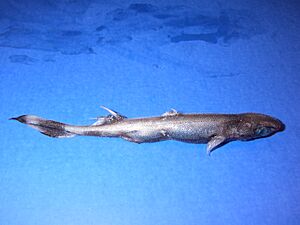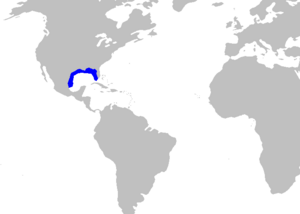Fringefin lanternshark facts for kids
Quick facts for kids Fringefin lanternshark |
|
|---|---|
 |
|
| Conservation status | |
| Scientific classification | |
| Genus: |
Etmopterus
|
| Species: |
schultzi
|
 |
|
| Range of the fringefin lanternshark (in blue) | |
The fringefin lanternshark (Etmopterus schultzi) is a small, glowing shark that lives deep in the ocean. It belongs to the family called Etmopteridae, known as lanternsharks. You can find this shark only in the western central Atlantic Ocean, from Texas to Florida, including the northern Gulf of Mexico and Mexico.
This shark lives very deep underwater, usually between 220 and 915 meters (about 720 to 3,000 feet) below the surface. That's on the upper parts of the continental slopes in the Gulf. Fringefin lanternsharks are quite small, growing to about 27–30 centimeters (10-12 inches) long. They mostly eat squid. These amazing sharks can also make their own light, which helps them hide and talk to other sharks of their kind.
Contents
What is a Fringefin Lanternshark?
The fringefin lanternshark was first identified in 1953 by three scientists: H.B. Bigelow, W. C. Schroeder, and S. Springer. They wrote about it in a science journal.
The group of sharks called Etmopteridae are often called lanternsharks. This is because they have special organs on their bellies that produce light. These organs are called photophores, and they make the sharks bioluminescent, meaning they can glow in the dark!
There are five main groups, or genera, of lanternsharks. The largest group is Etmopterus, which includes 41 different species, like our fringefin lanternshark.
These sharks get their name from the unique "fringe" on the edges of their fins. This fringe is made by tiny fibers called ceratotrichia, which support fish fins.
Where Do Fringefin Lanternsharks Live?
E. schultzi lives in very deep water, from about 220 to 915 meters (720 to 3,000 feet) below the surface. They prefer the upper parts of the continental slopes in the Gulf of Mexico.
They are found only in this area, which means they are endemic to the Gulf. Their home stretches from the deep waters off Eastern Mexico, across the southern United States, and near Western Florida.
What Do Fringefin Lanternsharks Look Like?
Male E. schultzi sharks are usually about 27 centimeters (10.6 inches) long. Females are a bit bigger, reaching about 28–30 centimeters (11-12 inches) long.
Their upper bodies are light brown, and their bellies are a dark gray color. They have a dark spot behind and above their pelvic fins, near the base of their tail. The edges of their fins look fringed because of the special fibers that run through them.
Their skin is covered in tiny, hooked scales called denticles, which are mostly found on their snout. Their gill openings are short. The second dorsal fin (the one closer to the tail) is about twice as big as the first dorsal fin (the one closer to the head). Like all sharks, they have a heterocercal tail fin, which means the upper part of the tail is longer than the lower part.
How Do Fringefin Lanternsharks Live?
What Do Fringefin Lanternsharks Eat?
Fringefin lanternsharks are known to eat squid. Some scientists think these sharks might even swim together in groups to hunt for food. However, we don't know a lot about how they find and catch their meals.
How Do Fringefin Lanternsharks Reproduce?
Fringefin lanternsharks probably use their special glowing patterns to find mates. These patterns are unique to each species, helping them recognize each other in the dark ocean.
Even though scientists haven't studied how these specific sharks reproduce, they are likely ovoviviparous. This is a fancy word meaning the mother keeps the eggs inside her body. The baby sharks grow by feeding on the yolk inside their eggs. Once they are fully developed, the mother gives birth to live young. This is different from mammals, where babies get food directly from the mother through a placenta.
How Do Fringefin Lanternsharks Glow?
Lanternsharks, including the fringefin lanternshark, are bioluminescent. This means they can produce their own light from their bellies. Unlike some other glowing sea creatures, lanternsharks don't rely on tiny glowing bacteria. Instead, they have their own light-producing organs called photophores.
Many photophores cover the shark's belly. Each photophore has tiny parts that make light. They also have a part like an iris in an eye, which might let the sharks control how much light they make.
Sharks use this glow for two main reasons:
- Counter-illumination: Imagine looking up from deep in the ocean. If the shark didn't glow, its dark outline would be easy to see against the dim light from above. By glowing, the shark's belly matches the light from the surface. This helps them hide from predators and sneak up on prey.
- Social interaction: The way the photophores are placed creates special glowing patterns on each shark. These patterns are different for each type of lanternshark. This allows sharks to recognize others of their own kind from far away, even up to 700 meters (about 2,300 feet)! This is very important for finding mates or swimming together in groups in the dark deep sea.
Fringefin Lanternsharks and Humans
Fringefin lanternsharks are not important for fishing. However, they are sometimes accidentally caught in deepwater fishing nets. This is called "bycatch."
Scientists haven't done a full study to see how many fringefin lanternsharks there are. But there is some concern that the 2010 oil spill in the Gulf of Mexico might have harmed them. A large part of where these sharks live was affected by the oil spill. More research is needed to understand how the spill truly impacted their population.


